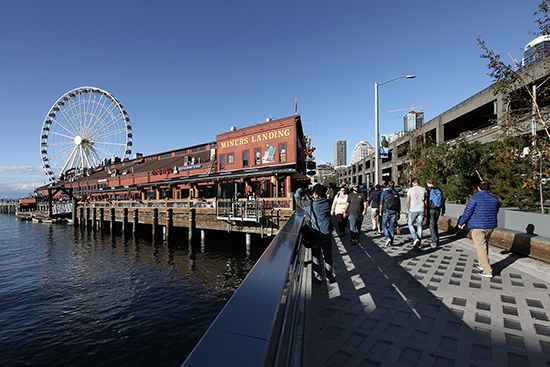|
Subscribe / Renew |
|
|
Contact Us |
|
| ► Subscribe to our Free Weekly Newsletter | |
| home | Welcome, sign in or click here to subscribe. | login |
Architecture & Engineering
| |
 |
January 23, 2017
National finalist: Platinum award
Environmental design
Magnusson Klemencic Associates

Project: Elliott Bay Seawall habitat and public space
Client: City of Seattle
Seattle’s downtown waterfront is a critical economic center for the city and the region, with more than 19 million visitors annually generating more than $9 billion in tourism revenue and $623 million in state and local taxes. One of the waterfront’s main players, the Port of Seattle, generates $19.8 billion in business revenue and $894.4 million annually in state and local taxes.
But a dark cloud hung over the city.
Even with the removal of the Alaskan Way Viaduct, Seattle’s downtown waterfront seawall was at great risk of collapse in the next earthquake, with its liquefiable soils, and having been pummeled by tidal forces, wind-driven waves and underground marine borers for the past 75 years. The Seattle Department of Transportation, in response, developed the Central Seawall Project (CSP) to replace 3,700 linear feet of the dilapidated seawall with a stronger, better and more seismically resistant seawall that would last at least another 75 years.
From the start, the city’s goals were clear: Provide a new earthquake-resistant seawall, improve the near-shore marine environment, and restore a long-interrupted salmon migration route. The city selected a team headed by Parsons, but stipulated that Magnusson Klemencic Associates must be part of the team in a key leadership role based on their past work for the city. MKA became the “public realm lead,” responsible for integrating all urban design, art, and landscape and habitat components into CSP’s construction documents.
One of the big challenges of the project was to improve the waterfront’s adjacent marine environment. The canyons and shadows created by Seattle’s urbanized shoreline were drastically impacting native salmon traveling along their waterfront migration route, delaying their journey, limiting food sources and exposing them to predators. Research had shown that 29 percent of the area’s pre-settlement salmon population had become extinct, and 27 species are threatened, including the chinook.
With 90 percent of Seattle’s central waterfront shoreline covered by piers, the project had to include bringing natural light beneath the promenade since research had shown salmon migration was encouraged by as much natural light as possible. Traditional steel grating and other openings in the promenade were ruled out because they would compromise safety for pedestrians above.
MKA needed to come up with another answer. The firm conducted a customized two-month study of potential light levels using movie industry technology that included positioning light meters at key elevations in a model to observe how light moved through the promenade surface to the water surface, and even to fish-eye depth.
MKA’s engineers then created a custom light-penetrating pedestrian promenade using glass pavers that is stacked over the salmon migration corridor by siting the new seawall face 15 feet landward of its old location. This innovation gives both human and fish habitats ample space to thrive.
MKA also conducted research into marine surface texture designs that would increase habitat biodiversity and encourage marine life attachment, guiding the development of a two-inch-thick “texture zone” of the precast concrete seawall that had textured bands of sea organisms layered to ocean habitat, plus imprints of tidal transitions.
The Central Seawall Project’s very sensitive nature, highly public location, extremely large size and long list of “neighbors” required that MKA have excellent communication and project management skills, as well as technical expertise and creative problem-solving abilities. The list of actively involved agencies and stakeholders included Washington State Ferries, the U.S. Army Corps of Engineers, the U.S. Fish & Wildlife Service, the state departments of Natural Resources and Ecology, several Native American tribes, the Seattle Office of Arts & Culture, waterfront pier owners and businesses, and many more.
John Buswell, roadway structures manager for Seattle’s Department of Transportation gave special kudos to MKA for their pioneering light-penetrating surface, which “has never been used in a waterfront setting. This unique and innovative design is a first for providing both a functional pedestrian surface and needed sunlight to marine habitat…This system is a model for other waterfront communities.”
Judges commented that replacing the existing seawall in downtown Seattle was a complex undertaking in its own right. But finding a way to incorporate ecological enhancements into the basic structural requirements of the new seawall made this project stand out.
Other Stories:
- National finalist: Gold award
Studies, research and consulting
WSP Parsons Brinckerhoff/EnviroIssues - Best in state: Gold award
Complexity
Wood Harbinger - Best in state: Gold award
Complexity
BergerABAM - Best in state: Gold award
Social, economic and sustainable design
Landau Associates - Best in state: Gold award
Future value to engineering profession
DLR Group - Best in state: Gold award
Unique or innovative applications
Otak - National finalist: Gold award
Transportation
McMillen Jacobs Associates - National finalist: Gold award
Water resources
Shannon & Wilson - National finalist: Gold award
Waste and stormwater
Brown and Caldwell - National finalist: Gold award
Structural systems
HDR Engineering - National finalist: Gold award
Structural systems
COWI North America - Best in state: Gold award
Successful fulfillment of client/owner needs
Welch Comer Engineers


